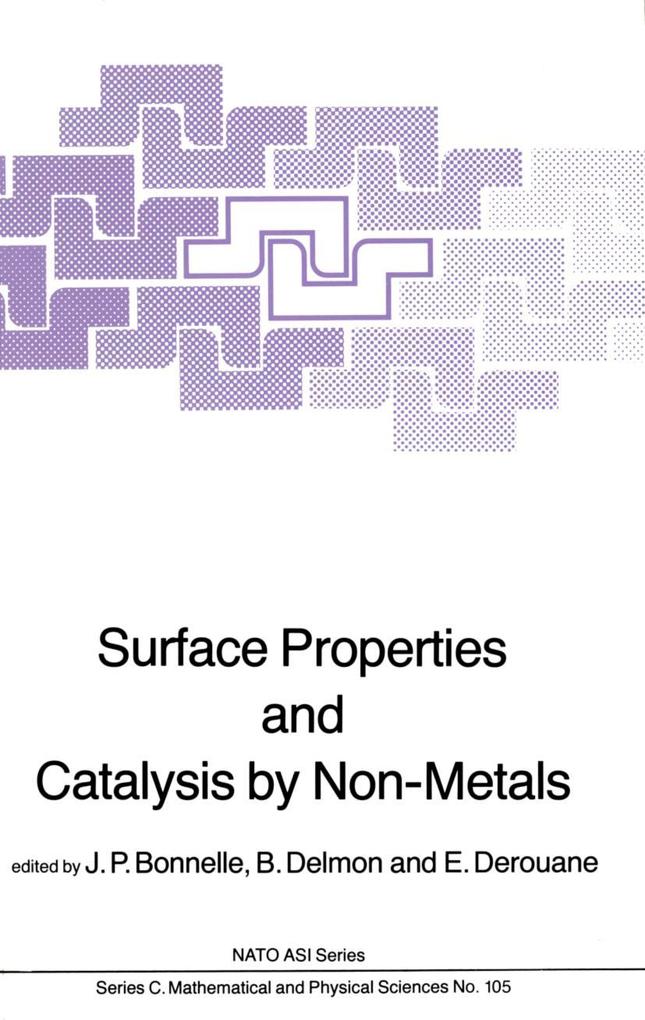
Zustellung: Sa, 12.07. - Mi, 16.07.
Versand in 7 Tagen
VersandkostenfreiBestellen & in Filiale abholen:
In the field of heterogeneous catalysis. it is convenient to distinguish. in a perfectly unjustified and over··simplified way. bet:leen metal catalysts. 2nd the other catalysts. The fj. J"st are easy to define : they are those in which a reduced metal is the active phase. It is thus easy to circumscribe. by exclusion, the other class namely the "non-metals". We have adopted this definition for the sake of our colleagues working on catalysis by metals, and to avoid a lengthy title like "sm' face pl"operties and catalysts by transi tion metal oxides. sulftdes, carbides, nitriles, etc. Defined in this manner, non-metal catalysts represented, in 1980, 84 wt. % of the industrial heterogeneous catalysts. To be more specific, this proportion corresponds to catalysts which, under the working conditions in the industrial ? lant. contain their catalytically active metallic elements in a non-reduced state. It should however be recalled that most metal catalysts are supported on oxides, which, often, repl'esent over 90% (sometimes 99. 4% in the case of the platinum reforming catalysts) of the total weight.
Inhaltsverzeichnis
Concepts in Catalysis by Transition Metal Oxides. - Electronic Structure Calculations Using Atomic Orbital Methods: Applications to Transition-Metal Compounds and Surfaces. - Bulk and Surface Structures of Non-Metals. - Physical Methods for the Characterization of Non-Metal Catalysts. - Photoelectron Spectroscopy Investigation for Non-Metal Catalysts. - An Example of Complementarity of Two Techniques: XPS and Laser Raman Spectroscopy to Characterize Hydrotreating Catalysts. - Characterization of Non-Metals by Electron Microscopy. - Analytical Electron Microscopy. - UV-Visible Diffuse Reflectance Spectroscopy Applied to Bulk and Surface Properties of Oxides and Related Solids. - Selective Oxidation and Ammoxidation Catalysis: History of Catalyst Design. - Selective Oxidation and Ammoxidation Catalysis: Mechanism and Commercial Practice. - Hydroprocessing I. Industrial Aspects. - Hydroprocessing II. Fundamental Aspects. - Catalysis by Transition Metal Sulfides. - Surface Area Effects on Some Physicochemical and Catalytic Properties of MoS2 (WS2). - Kinetics in Hydrodesulfurization of Thiophenic Compounds. - Localized Aspects in Heterogeneous Catalysis. - Non-Metallic Pseudo-Metals. - Spillover on Non Metals. - Hydrogen Bronzes: A Review of Some Their Physical and Catalytic Properties. - The Activity of Metal Oxides in the Oxidation of Hydrogen and Carbon Monoxide. - Author Index.
Produktdetails
Erscheinungsdatum
31. Juli 1983
Sprache
englisch
Auflage
1983
Seitenanzahl
580
Herausgegeben von
J.P. Bonnelle, B. Delmon, E.G. Derouane
Verlag/Hersteller
Produktart
gebunden
Abbildungen
XIV, 562 p.
Gewicht
1027 g
Größe (L/B/H)
241/160/36 mm
ISBN
9789027716071
Entdecken Sie mehr
Bewertungen
0 Bewertungen
Es wurden noch keine Bewertungen abgegeben. Schreiben Sie die erste Bewertung zu "Surface Properties and Catalysis by Non-Metals" und helfen Sie damit anderen bei der Kaufentscheidung.










